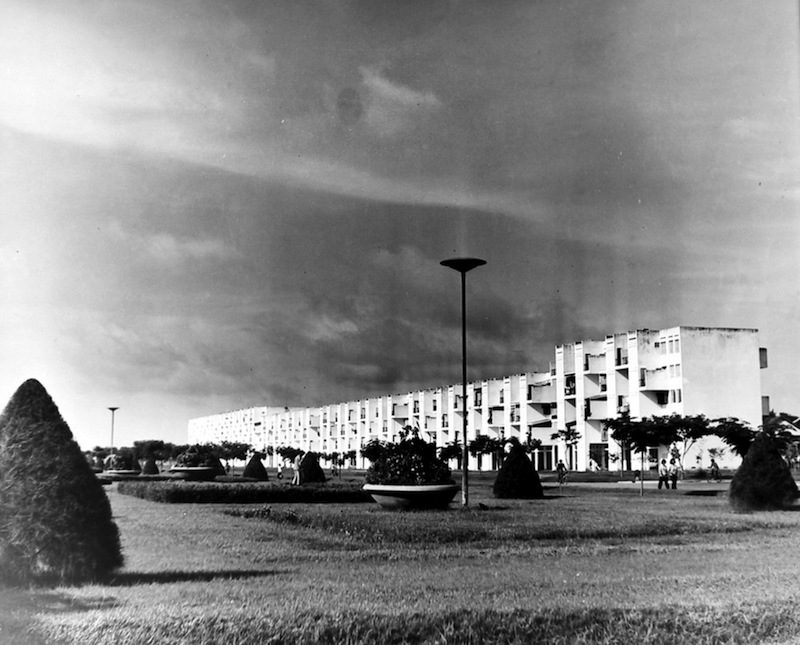
End of an Era
In the 1960s, Phnom Penh’s White Building symbolized progress—a new Cambodia. Now the housing complex is being demolished, taking an architectural ‘Golden Age’ along with it
By Kate Ginn and Anandha Loustau
July 28, 2017
The lawns are immaculate, a uniform line of neat shrubs dotted around a serene garden. A sprawling new apartment block, pristine white, clean and fresh, glistens as bright as the future it promises for a new Cambodia.
This is the White Building as it was meant to be: a potent symbol of urban social development. Photographs from the 1960s show a building—known then as the Municipal Apartments—that is almost unrecognizable as the dilapidated landmark associated with the name today.
Inaugurated in 1963, the White Building was a utopian vision, built on the dream of transforming reclaimed land along the Bassac River and creating a type of development Phnom Penh had never seen before.
It was the first low-rent housing complex, offering affordable community living on a large scale.
Last week, excavators got to work demolishing the complex and with it, all for which the building once stood.
“Today, it is the shadow of its former self,” says art historian Darryl Collins, co-author of “Building Cambodia: New Khmer Architecture, 1953-1970,” of the White Building.
The landscaped garden had long gone, replaced by a chaotic vista of ramshackle shops, garbage piles and traffic. The dirt track that once ran in front of the block had been transformed into a narrow lane filled with food carts. Where grass once grew, Sothearos Boulevard now stretched, teeming with motorbikes, noise and pollution.
The once-gleaming white concrete exterior sat cracked and blackened, from mold and years of neglect.
Earlier this week, as dark rain clouds swirled above, a dirty yellow digger started razing the building—and the community that called it home—with ruthless precision. In a cacophony of rumbling machines and crunching gears, the excavator tore into a wall of concrete and brick, sending rubble crashing to the ground.
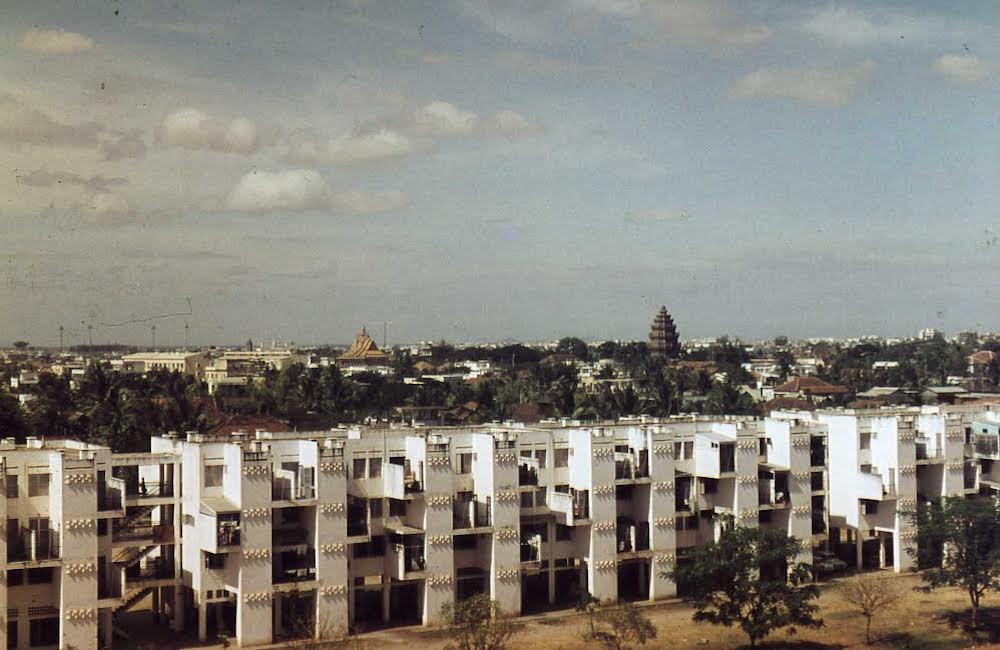
A handful of curious spectators watched from behind the construction tape sealing off the area.
Architect Pen Sereypagna was not among them. The 30-year-old director of the Vann Molyvann Project, which has been documenting the history of the White Building as part of a wider project on the architect’s transformative legacy, kept his distance as the dismantling began.
“It would be quite emotional for me to see the building being torn down,” Mr. Sereypagna says. “I have been documenting it for nearly 10 years.”
“It’s not just a piece of stone that is being lost but people’s memories,” he adds. “You are knocking down a place where people made memories; lived and struggled and worked there.
“The building was very different to how it once was, but it was still a living, breathing part of Phnom Penh. We feel very sad that we have lost a part of the history of the city.”
Mr. Collins, the art historian, says an important element of the city’s history will go with the White Building.
“It’s not in the pristine condition it was in the ’60s, of course, but people still lived in it and lived in it until very recently, so it represents a public housing experiment that is still valid and was still valid until a month or so ago,” he says.
“I think as an historian, it’s sad that it’s going to be demolished,” he adds, even though it had reached a stage of “almost no return” a few years ago.
In the 1950s and 1960s, Cambodia went through a period of prosperity that heralded what is known as the “Golden Age” or Era, with the rise of New Khmer Architecture and cultural innovations leading a modern movement.
The White Building—built on 24 hectares of land along the river—was part of an ambitious scheme for a new Phnom Penh.
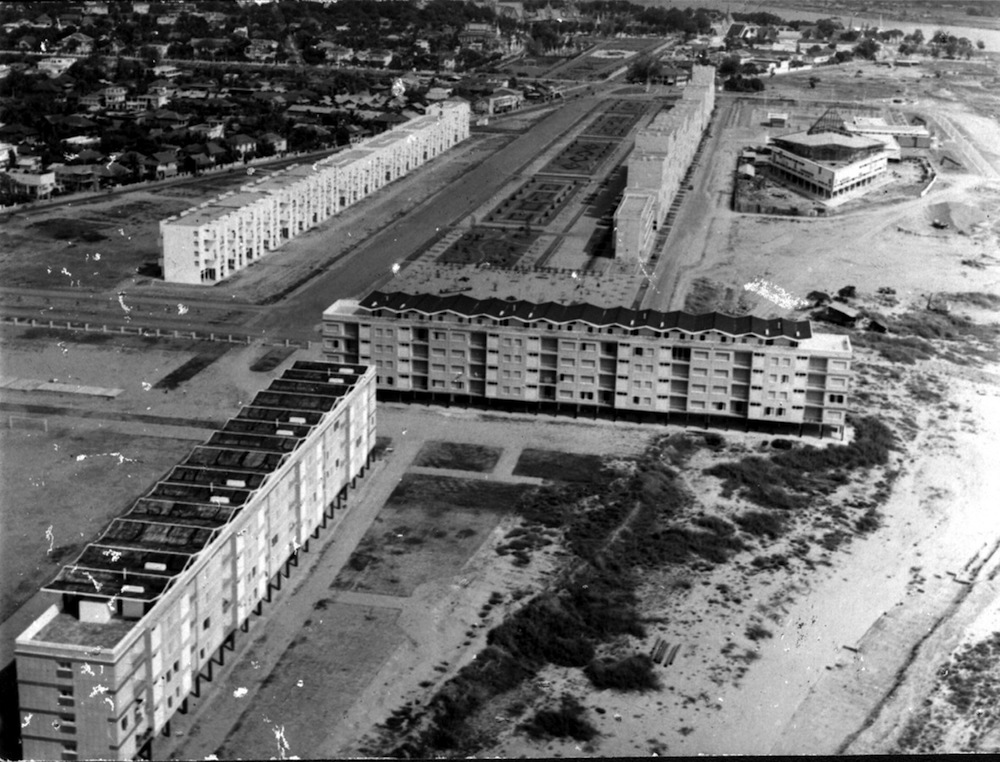
Mr. Collins’ book describes how in June 1961 Prince Norodom Sihanouk told Phnom Penh governor Tep Phan that “our capital must deal with the problem of the urban population.”
His answer was an apartment complex, and an international team of town planners, led by French urbanist Gerald Hanning, who was brought in, under the guidance of Russian-born engineer Vladimir Bodiansky.
Along with the Municipal Apartments, another complex would follow in 1964, built for the Southeast Asian Games, which never took place, and the National Theatre in 1968, which was damaged in a 1994 fire and demolished in 2008.
Many people mistakenly believe that Vann Molyvann, Cambodia’s renowned architect, was the sole designer of the White Building. While he oversaw and contributed to the project, the complex was actually inspired by an Algerian housing project designed by Vladimir Bodiansky’s company ATBAT, according to Mr. Collins.
The design of the six low-rise reinforced concrete blocks, 300 meters long, was unprecedented for the time, in “stark contrast,” Mr. Collins’ book notes, to the developments based on the Chinese “shop house” model that was popular at the time.
According to the book, “Vann Molyvann had misgivings about this kind of development from the start. It did not correspond to the traditional way of life of the typical Cambodian family.”
The original 468 apartments had open kitchens and bathrooms to allow a cooling breeze to run through and temper the worst of Cambodia’s tropical climate. While retaining their separateness, the blocks were joined by an open staircase. The Grey Building—a second complex built behind—used a similar model, but met a different fate.
Community living and making use of the outdoor space was integral to the project, Mr. Collins says. “They were very much seen as revolutionary in the sense of their environmentally friendly design,” he
says.
For Mr. Sereypagna, the architect, the White Building is just as important for its social history as its architectural relevance.
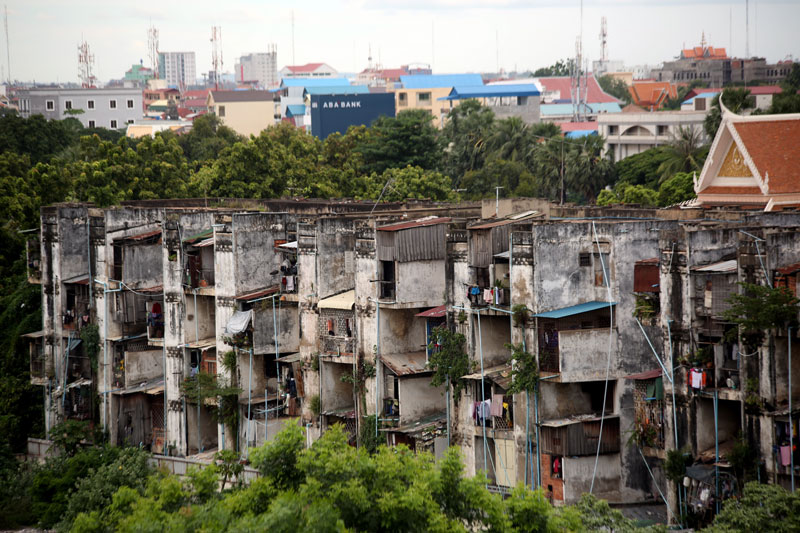
In the 1960s, he says, it was home to a diverse population, ranging from artists to low-income families. When the Khmer Rouge regime ravaged Phnom Penh in the 1970s, it lay empty, though its structure survived.
“In the ’80s, a big art community were put there by the Ministry of Culture because it was next to the National Theatre,” Mr. Sereypagna says. “A lot of artists were living and working in the White Building.”
In the next decade, the dancers and actors were mostly replaced by an influx of migrants from the provinces, bringing a new kind of resident to the White Building, he says, such as tuk-tuk and motorbike-taxi drivers. The ground-floor spaces were opened up.
In later years, the White Building would become synonymous with drugs, crime, poverty and prostitution, a dark reputation that it found hard to shake off, despite also housing artists, poor families and children.
“When I was 20 or 21, I volunteered to teach English at a school there,” Mr. Sereypagna says. “I had never been to the White Building before, but I had heard bad stories about the place and I was frightened to go.”
“I remember walking under the open staircase and to the back of the building, where there were these wooden houses,” he says. “The school was in a wooden building too and there were four or five students, aged 6 to 8, waiting for us,” he says. “I taught there every day and I got to know the community, who were very welcoming, and it changed my idea about the White Building.”
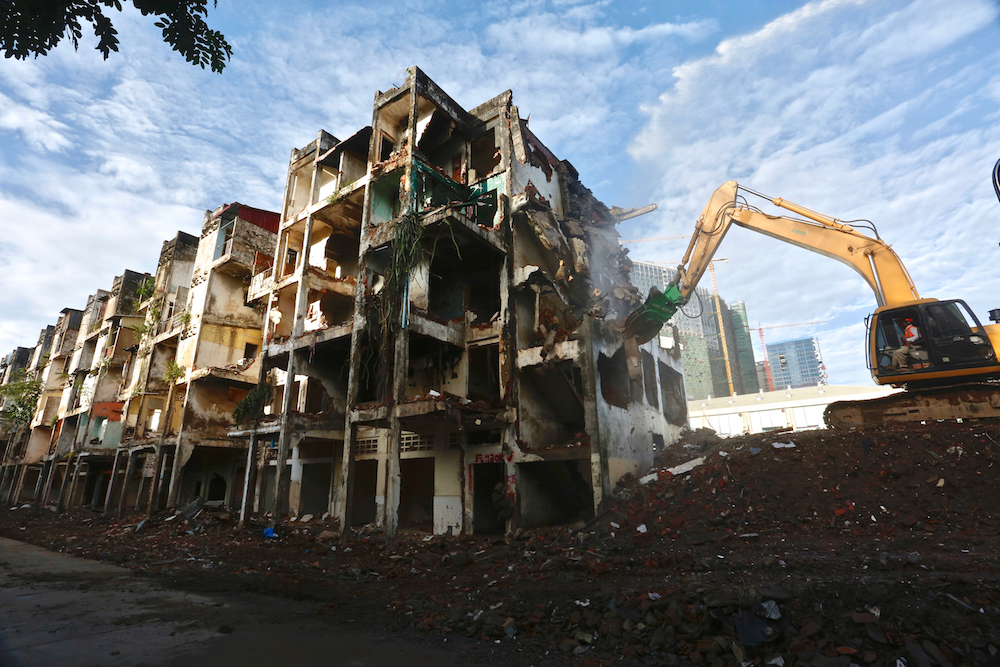
The experience was partly why Mr. Sereypagna decided to become involved with the archiving of the building in later years.
To some, the White Building’s colorful community was part of its charm.
“My father and I liked the White Building because it is a beautiful piece of architecture and because of the way its communities survived through these years and made it such an amazing village inside the city,” says Delphine Vann, the daughter of Mr. Molyvann.
Until recently, Ms. Vann was involved with the White Building’s Aziza school, which taught children living in the complex for the past decade. The school run by the NGO Empowering Youth in Cambodia was evicted along with the other tenants.
“For my colleagues and the families of the students, the destruction of the White Building is sad and shocking, because this was their home for most of their lives, and they loved it,” Ms. Vann says.
Yet the building was already being “suffocated” by the “ugly” development around it, Ms. Vann says.
“The destruction of the White Building illustrates the type of change that is going on in Phnom Penh at the moment,” she says. “Developers are not interested in ‘good and beautiful architecture.’ They are not interested in preserving the past and its old buildings…They are only interested in making quick money at any price. So they’d rather destroy an old building than making it anew.”
All the 493 families who called it home have moved out, after owners accepted compensation of $1,400 per square meter for their apartments. Many left piles of possessions—shoes, teddy bears, bags and plants—that were scooped up by the digger’s bucket and taken away, as they scooped up their own lives and moved on.
Ms. Vann says her bedridden father is aware that the White Building is being torn down. Asked about his reaction, she would only say, “The White Building and the whole Front du Bassac was a symbolic project in terms of Cambodia’s history. And so for my father it was part of the ‘Golden Era’ of his country.”
Mr. Sereypagna, who met Mr. Molyvann through the work on the Vann Molyvann Project, says the architect told him the White Building was for the community and that the community had a right to be in the center of the city. And he knows the building has met its end.
“He has heard the stories and he is already upset,” he says. “When you design a building, you put your heart into it, and then suddenly it’s gone.”




